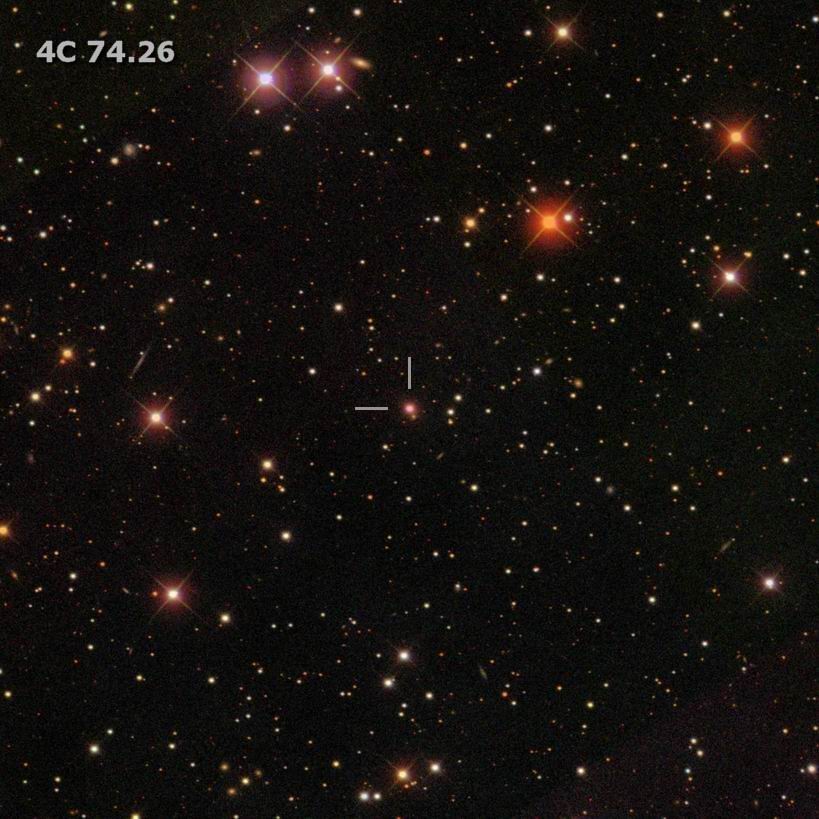
| Frankfurt Quasar Monitoring |
| 4C
74.26 |
| Cross-Identifications |
S5
2043+749, LEDA 2821908, KUV 20432+7457 4C +74.26, 87GB 204308.7+745733, 2043+749 1RXS J204235.3+750758, SWIFT J2043.0+7504 GB3 2043+749, 2MASS J20423730+7508024 |
| Equat. coordinates | RA 20 42 37.3 DE +75 08 02 (J2000) |
| Constellation | Cepheus |
| Type |
QSO |
| Redshift | z=0.104 |
|
Distance (2) (3) |
416 Mpc |
| Total mag range (mv) (4) (5) | 14.2 - 15.1 |
| Catalog Magnitude (1) | 15.13 |
| Absolute Magnitude (1) | -23.9 MB |
| Light Travel-Time (2) | 1.293 × 109 yrs |

Comparison stars
| star
|
V |
| A | 14.33 (0.05) |
| B | 14.52 (0.05) |
| C | 16.10 (0.05) |


| 4C 74.26
is a bright quasar in Cepheus, located very close to the constellation Draco.
4C 74.26 was
discovered in 1964/1965 as a radio source by the 4. Cambridge Radio
Survey (4C), catalogued as 4C +74.26. As a radio source it was also observed by the 100-m radio telescope at Effelsberg/Germany during the S5-Radio Survey in 2/1977 and 3/1978. Soon after, a blue stellar object of v=15m.1 was found as the optical counterpart. Independently, this blue stellar object was discovered in 1980 by the KISO-Survey (KUV), searching for UV-bright stellar objects. Follow-up spectroscopic investigations in 1986 revealed a Seyfert:1-spectrum, which led to the quasar classification. Quasar 4C 74.26 was also detected as an X-ray source by the HEAO-A1 satellite in 1978, by ROSAT (RX) in the early 1990s, and later by SWIFT. The quasar host is a radio galaxy, which radio astronomers classified as a Giant Radio Source (GRS), consisting of a prominent core and a one-sided radio jet. This radio-loud quasar is a strongly variable radio source, also classified a Flat-Spectrum Radio Source. Quasar 4C 74.26 is a weakly variable object with a total range of only about 1 magnitude (14.2-15.1 mag) in the optical. For most of the time it appears bright with an apparent magnitude of about 14m.4-14m.5. This object is an attractive target for visual observers with at least an 8- to 10-inch telescope or larger. Even in large aperture telescopes 4C 74.26 remains a stellar object. CCD observers, as well as visual observers, may use the comparison stars given above. The comparison stars were calibrated from USNO A2.0, as part of the Frankfurt Quasar Monitoring project. No photometric sequence has been published to date. Quasar 4C 74.26 is located in western Cepheus, very close to the border of Draco. The position of 4C:74.26 lies halfway between the two bright stars Beta Cephei and Kappa Cephei. The 5.1-mag star 73 Draconis is only 44´ away to the west. ____________
Observers who look for a very special object may turn to 16-mag high redshift quasar HS 1946+7658, some 4° NW, located at a distance of more than 9×109 light-years. Another bright quasar is PGC 61965, a 14-mag object (9° W) at a distance of about 1.5×109 light-years. Finally you may focus on BL Lac object 3C 371, another bright 14-mag extragalactic variable, at a distance of about 0.6×109 light-years, 12° W of 4C 74.26. The close vicinity of quasar 4C 74.26 is void of bright deep sky showpieces. But turning the telescope some 7° to the south we find NGC 7023, a bright reflection nebula, also dubbed the "Iris-Nebula". Further to the south-west, we reach the outskirts of the Milky Way. Here we find an interesting pair of open clusters: NGC 7142 and NGC 7129. NGC 7142 is a pretty bright, rich and old open cluster, some 10° SW of 4C 74.26. Located only 20´NE of NGC 7142 we arrive at NGC 7129, a very young open cluster, embedded in the reflection nebula IC:5134. |
| Biermann, P.L., Schaaf, R., et al. 1992, A&AS, 96, 339; X-ray observations of flat spectrum radio sources with the HEAO-A, Einstein and EXOSAT observatories. Branson, N. 1967, MNRAS, 135, 149; A Radio Survey of the sky north of Declination 70° at a frequency of 81.5 Mc/s. Darling, G.W., Wegner, G. 1994, AJ, 108, 2025; Spectral types for objects in the KISO survey. IX: Data for 121 objects. Karge, S.; Helle Quasare für 8- bis 10-Zoll Teleskope. Ein Beobachtungsführer zur visuellen Beobachtung von Quasaren und BL Lacertae Objekten; Frankfurt 2005. Kühr, H., Johnston, K.J., et al. 1987, A&AS, 71, 493; Optical Identifications and Radio Morphology of the complete 5 Ghz S5 Survey. Kühr, H., Pauliny-Toth, I.I.K., et al. 1981, AJ, 86, 854; The 5-GHz strong source surveys. V - Survey of the area between declinations 70 and 90 deg. Riley, J.M., Warner, P.J., Rawlings, S., et al. 1988, MNRAS, 236, 13; 4C 74.26 - The largest radio source associated with a quasar. Véron-Cetty, M.-P., Véron, P. 2001, A&A 374, 92; A Catalogue of Quasars and Active Nuclei: 10th edition. Véron-Cetty, M.-P., Véron, P. 2003, A&A 412, 399; A Catalogue of Quasars and Active Nuclei: 11th edition. Véron-Cetty, M.-P., Véron, P. 2006, A&A 455, 776; A Catalogue of Quasars and Active Nuclei: 12th edition. Véron-Cetty, M.-P., Véron, P. 2010, A&A 518, 10; A Catalogue of Quasars and Active Nuclei: 13th edition. Wegner, G., McMahan, R.K. 1988, AJ, 96, 1933; Spectral types for objects in the KISO survey. IV - Data for 81 stars. |
| Link: Sloan Digital Sky Survey |
| home |